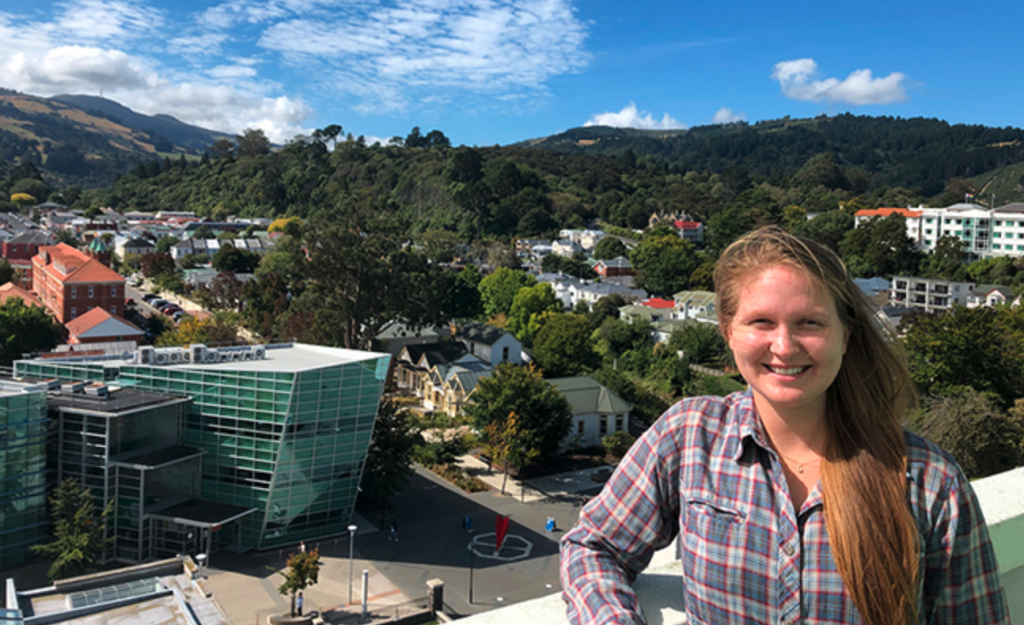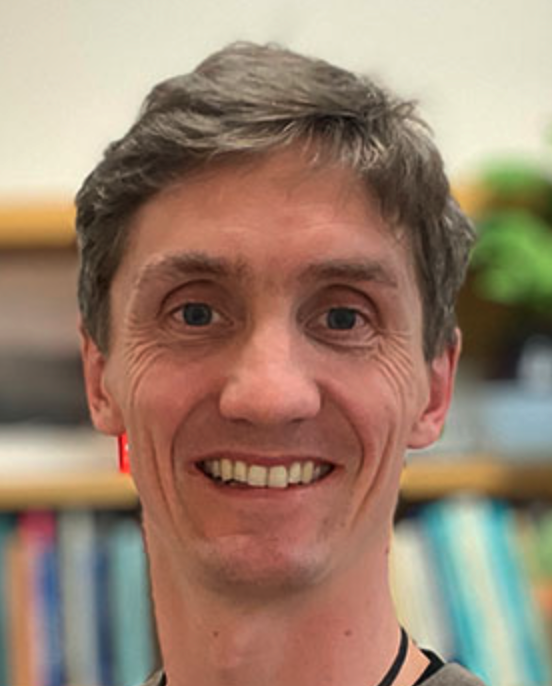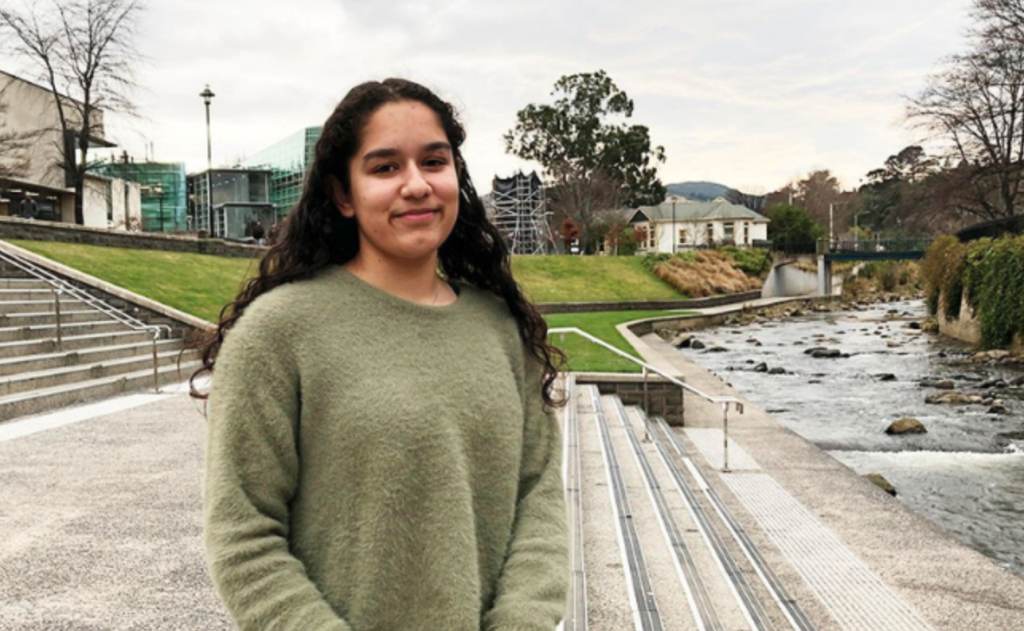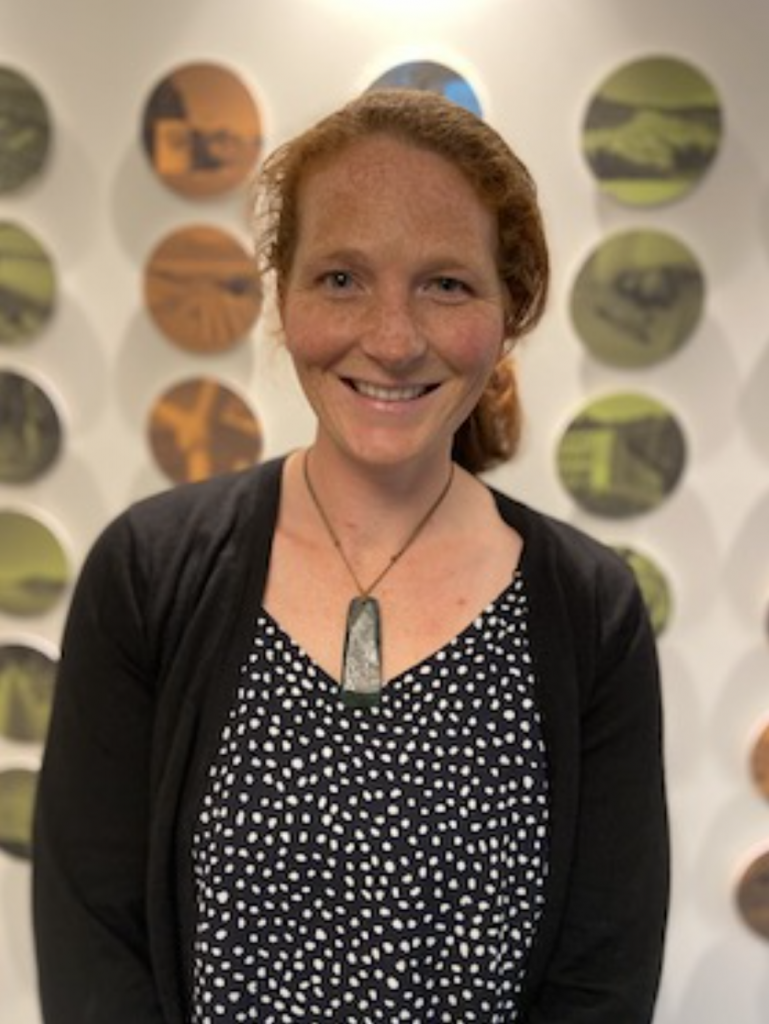
A University of Otago PhD candidate has been chosen as the only person from Aotearoa NZ to receive a $10,000 Australian scholarship and 50,000 hours of computing time, which she will put towards her research in ozone hole depletion.

A University of Otago PhD candidate has been chosen as the only person from Aotearoa NZ to receive a $10,000 Australian scholarship and 50,000 hours of computing time, which she will put towards her research in ozone hole depletion.
Dipolar interactions are fundamentally different from the usual van der Waals forces in real gases. Besides its anisotropy, the dipolar interaction is nonlocal and as such allows for self organized structure formation, like in many different fields of physics. Although the bosonic dipolar quantum liquid is very dilute, stable droplets and supersolids as well as honeycomb or labyrinth patterns can be formed due to the presence of quantum fluctuations beyond mean field theory.

Niels works in experimental atomic and laser physics. At Otago his research group has constructed an optical tweezers platform, where powerful laser beams can pinch and manipulate clouds of atoms at temperatures less than one millionth of a degree above absolute zero.
In the Marsden-funded project ‘Littlest Hadron Collider: a Laser-based Accelerator for Ultra-cold Atoms’, they used their optical tweezers for gently bumping frigid atomic clouds together to explore the nature of interactions between atoms colliding at pedestrian speeds. The experiments captured paradigms of quantum mechanics by literally photographing scattered atoms and the project ‘Reactive Cold Collisions in Steerable Optical Tweezers’, recently funded by Marsden, aims to extend their method to the realm of ultracold chemistry.
Niels’ interests also include the two-way, entangled interplay that happens when light and matter meet to interchange information and polarisations become twisted, rays get bent, and atoms are pushed around by light. The observation of Pauli blocking of light scattering published in Science Magazine was selected as Top-10 breakthrough of 2021 by Physics World.
This lecture will be followed with light refreshments, tea, coffee and juice.
This event will be live-streamed, from 5:25pm Thursday, 9 March 2023, at the following web address:

Professor David Hutchinson, Director of the Dodd-Walls Centre Te Whai Ao, was last week awarded the prestigious Thomson Medal by the Royal Society Te Apārangi.
Professor Hutchinson received the Thomson Medal for his excellence in leading the successful bid and subsequent development of the Dodd-Walls Centre for Photonic and Quantum Technologies (DWC), and for his valuable contributions to early career researchers and community outreach programmes.
Jono Squire, Philip Brydon, Blair Blakie are among 24 Otago academics who have been granted a total of almost $19.8m in 2022 round of prestigious Royal Society of New Zealand Marsden Grants.
 Just above its surface, the Sun’s atmosphere (corona) suddenly jumps to more than a million degrees, escaping the gravitational pull to become the solar wind. Understanding how this occurs – specifically, how energy is released from tangled magnetic fields into heat – is an 80-year-old conundrum known as the “coronal heating problem”. Because the solar wind directly influences Earth, damaging satellites and power networks and causing the beautiful aurora, it impacts both astrophysics and everyday life. Its solution requires understanding the complex interplay between the Sun’s magnetic-field structure and local heating, while agreeing with decades of precision observations. The researchers recently discovered an effect, the “helicity barrier”, which changes how random, turbulent fluctuations become heat as they propagate outwards from the Sun. The effect has promising traits, unifying two previous theories and matching features of the solar wind observed by spacecraft. But, the results remain idealised so far. Using supercomputer simulations, this proposal will expand them into a theory of helicity-barrier-mediated coronal heating, characterising how global magnetic-field structures regulate local dissipation of fluctuations into heat. The goal is to unify seemingly disparate observational constraints under one framework, making testable predictions for the cutting-edge spacecraft that are currently exploring deeper into the corona than ever before.
Just above its surface, the Sun’s atmosphere (corona) suddenly jumps to more than a million degrees, escaping the gravitational pull to become the solar wind. Understanding how this occurs – specifically, how energy is released from tangled magnetic fields into heat – is an 80-year-old conundrum known as the “coronal heating problem”. Because the solar wind directly influences Earth, damaging satellites and power networks and causing the beautiful aurora, it impacts both astrophysics and everyday life. Its solution requires understanding the complex interplay between the Sun’s magnetic-field structure and local heating, while agreeing with decades of precision observations. The researchers recently discovered an effect, the “helicity barrier”, which changes how random, turbulent fluctuations become heat as they propagate outwards from the Sun. The effect has promising traits, unifying two previous theories and matching features of the solar wind observed by spacecraft. But, the results remain idealised so far. Using supercomputer simulations, this proposal will expand them into a theory of helicity-barrier-mediated coronal heating, characterising how global magnetic-field structures regulate local dissipation of fluctuations into heat. The goal is to unify seemingly disparate observational constraints under one framework, making testable predictions for the cutting-edge spacecraft that are currently exploring deeper into the corona than ever before.

Superconductivity is a quantum state of matter where electricity flows without resistance. It has found widespread application in the electrical generation of magnetic fields, but the strength of such magnets cannot exceed a critical field which destroys the superconductivity. The conventional theory of the superconducting state predicts an upper limit for this critical field, which is satisfied by almost all superconductors. Dr Brydon’s 2021 Science paper reported that superconductivity in CeRh2As2 survives fields far larger than this expected limit; furthermore, a distinct new superconducting state appears at high field strengths. He explained this unique behaviour as arising from the symmetries of its crystal lattice, which strongly constrains the motion of the electrons in the material. These symmetries are not uncommon, however, and may explain mysterious high-field behaviour observed in other superconductors. Moreover, the researchers propose that they can enable the observation of long-predicted excitations of the superconducting state, and may be exploited to realize novel microelectronic devices. This motivates the planned research to develop a comprehensive understanding of the role of these symmetries in superconductivity. This work will both fundamentally extend the microscopic understanding of superconductivity, and also open new frontiers in superconducting technology.

About half a century ago theoretical physicists speculated on a weird state of matter – the supersolid – possessing crystalline structure (solidity) and frictionless flow (superfluidity). The long quest to find a supersolid was successful in 2019 using a dilute quantum gas of highly magnetic lanthanide atoms. This project will develop a theory to describe the life cycle of these supersolids – from the dynamics of how they emerge during cooling or a temperature quench, through to their eventual demise due to atomic loss. The researchers’ approach involves developing and implementing a novel thermal (finite temperature) theory that describes the partially-coherent and incoherent dynamics of the system. This will enable them to capture the interplay of thermal fluctuations and supersolidity. They will apply this theory to quantify the finite temperature phase diagram of dipolar supersolids and to identify a pathway for labs to produce the next-generation of supersolids that exhibit two-dimensional crystalline structure.
 Jonathan Squire has been awarded the Thomas H Stix Award for Oustanding Early Career Contributions to Plasma Physics Research by the American Physical Society.
Jonathan Squire has been awarded the Thomas H Stix Award for Oustanding Early Career Contributions to Plasma Physics Research by the American Physical Society.
Congratulations Jono!
“For theoretical contributions to our understanding of plasma waves and turbulence in astrophysical plasmas and the solar wind, and for the discovery and characterization of a broad class of instabilities in dusty astrophysical plasmas”
Jonathan Squire is a Research Fellow and Senior Lecturer at the University of Otago in Dunedin, New Zealand. Following an undergraduate degree at Otago from 2005-2009, he was awarded a Fulbright fellowship for graduate study in the US, carrying out a PhD at the Princeton Plasma Physics Laboratory from 2010-2015. He then undertook a postdoctoral fellowship in the astronomy department at the California Institute of Technology, before moving back to the University of Otago as a Rutherford Discovery Fellow in 2018. Dr. Squire’s research covers a range of topics in astrophysical and space plasma theory, focusing particularly on how kinetic processes in plasmas impact their macroscopic properties such as heating, turbulence, and transport. Using numerical simulations and basic theory, he has applied these ideas in a variety of contexts including the turbulent heating of the solar wind and corona, collisionless plasmas with weak magnetic fields, magnetic-field amplification and self organization (dynamo), cosmic-ray transport, and planet formation in protoplanetary disks. For his PhD research on large-scale dynamos he was awarded the Marshall N. Rosenbluth Outstanding Doctoral Thesis Prize in 2017. Dr. Squire is a member of the American Physical Society and American Geophysical Union.

Two University of Otago students are thrilled to have won spots at an international event that will see them mingling with Nobel Prize winners.
PhD candidate Mohsin Ijaz, of the Department of Physics, and Bachelor of Science student Maia Dean both recently found out their applications to attend the Global Young Scientist Summit (GYSS) in Singapore next year were successful.
Robinson Research Institute develops electromagnetic and materials technologies and has a strong international reputation for superconductivity research. In this talk I’ll go into some of the outstanding problems we are working on to allow superconductivity to be a transformative technology in fields such as aviation, space propulsion and fusion energy.
The institute has also developed collaborative projects in fibre optic sensing and terahertz physics. We are developing spintronic THz emitters (STEs) made from magnetic thin films with the goal of improved conversion efficiency, throughput, and bandwidth. The programme in STEs combines expertise in both ultrafast laser technology and spintronics.
Zoom: Join from PC, Mac, iOS or Android: https://otago.zoom.us/j/95949217555?pwd=ZEJRMndHTUJSV0NiS24ranVTYmJNdz09 Password: 844392
All interested are welcome to attend
BSc(Hons 1) University of Otago, PhD Australian National University
Optical engineer, Baraja Pty Ltd

I chose to study at Otago because it was one of the top 2 universities in New Zealand with a very strong research presence. Knowing that I would likely to do a postgraduate degree in the future at the time, I wanted to study in a university with strong science research facilities and support. I also really liked the idea of having a campus that is centralised geographically, forming a strong sense of community. As I was the dux of my high school, the University of Otago Dux Scholarship was perhaps the deciding factor for me.
I have always liked science and maths from a young age. I had a very inspiring Physics teacher at high school which motivated me to learn more about the world in the sense of how things work and the mysteries of the universe, and in particular, quantum Physics, which was only taught through a Physics degree (in contrast to an engineering degree).
Bachelor of Science and Postgraduate Diploma in Energy Studies
Lead Hydrologist, Trustpower

I decided to study at Otago because of its reputation and the region appealed to me, due to the many outdoor opportunities.
Initially, I hadn’t considered Energy Studies, however, after a suggestion from my physics lecturer, I enrolled in a paper and never looked back! The small class sizes made for a nice community and we had plenty of good resources available to us.
I loved exploring Dunedin beaches, the wider Otago region and I got involved in some university sports clubs that introduced me to so many amazing people. I had only been to Dunedin once before moving there for university, so I had no idea what to expect. I remember being nervous but very excited! The staff and students were all very supportive and passionate, so I found it was an easy transition from leaving my small home town. Highlights and interesting memories of my time at Otago would be making lifelong friends and wearing beanies to bed to stay warm.